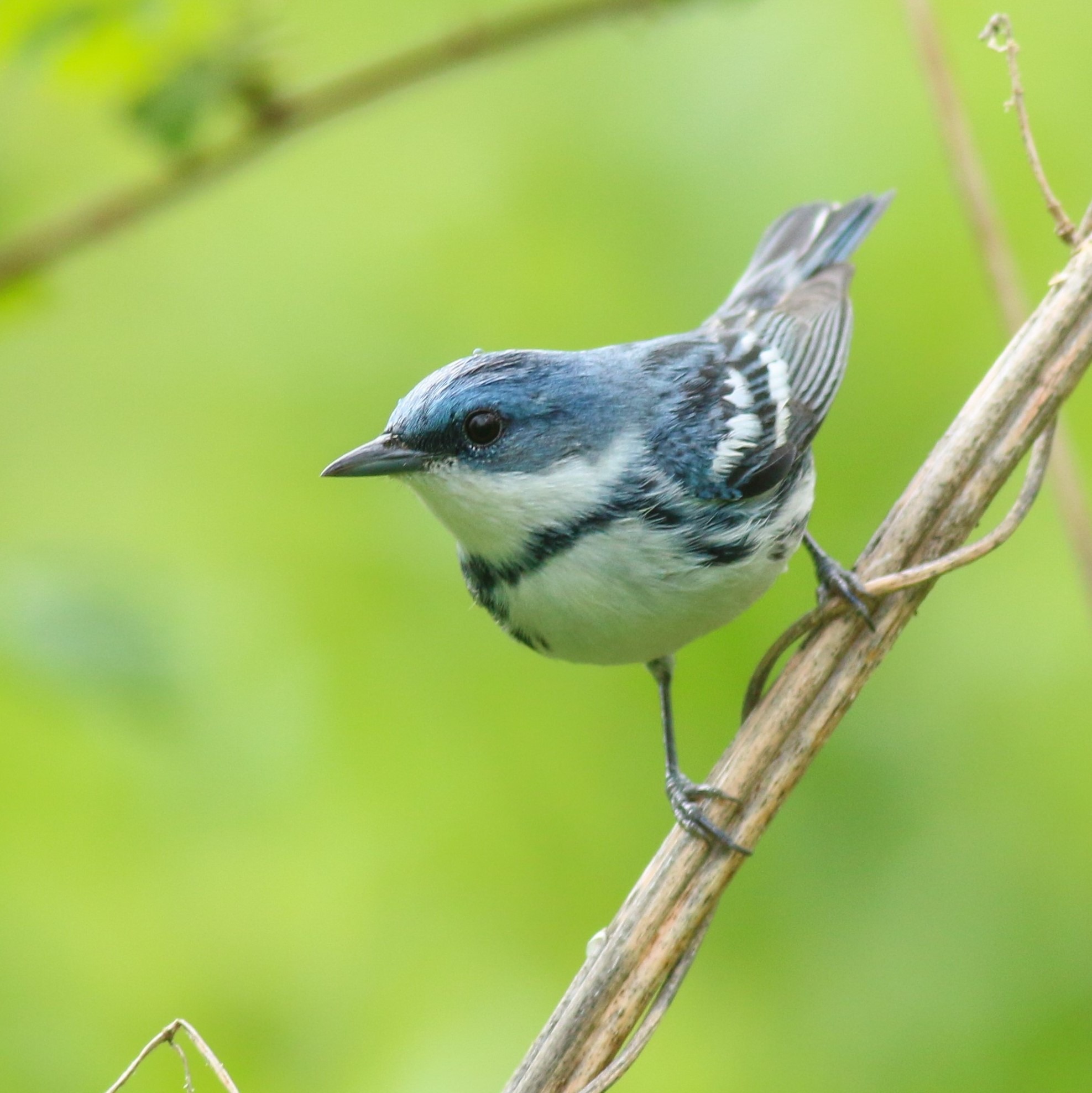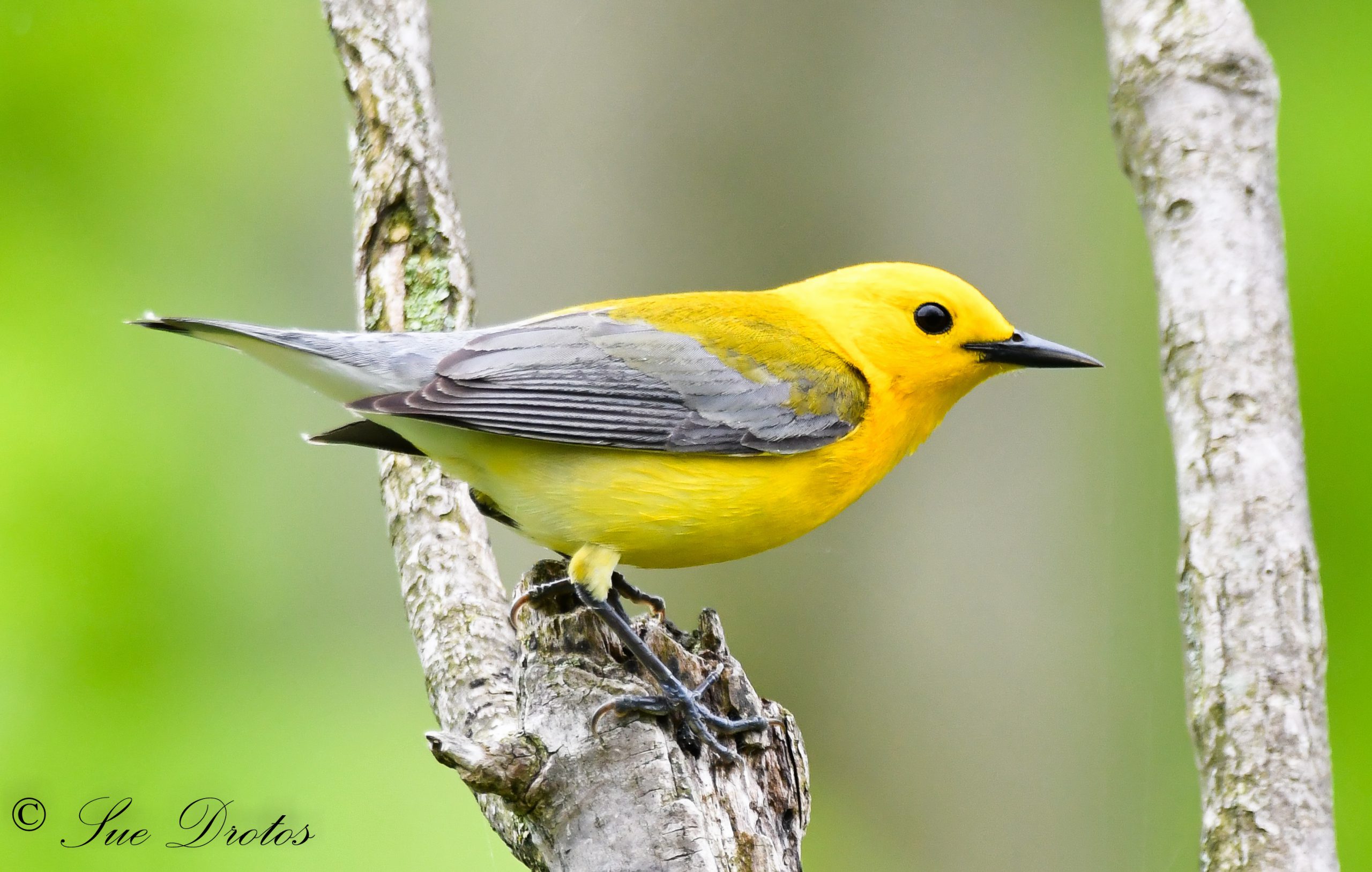Prothonotary Warbler
Protonotaria citrea
COSEWIC status: Endangered
Estimated Canadian population (individuals): 30
Appearance and population trend
With their bright colouration, Prothonotary Warblers deserve the nickname golden swamp warbler. Males are bright gold with an olive-green back and bluish-grey wings. Females have the same colour palette but are paler with an olive-green wash. Breeding Bird survey data shows a 40% decline in the continental population over a 40-year period. From 1995 to 2005 saw an 80% population decrease of Prothonotary Warblers in Ontario. It is proposed that more than one-third of the males remain single during a breeding season (COSEWIC 2007).
Location and habitat
In Canada, Prothonotary Warblers are found only along the shorelines of Lake Erie and Lake Ontario. Prothonotary Warblers live in deciduous swamp forests and riparian flood plains. These swamps are typically composed of silver maples, swamp ash, yellow birch, and willows. Unlike other at-risk forest birds, Prothonotary Warblers can live in forests with a range of canopy coverage – anywhere from 20% to 90% (COSEWIC 2007). They avoid marshes and shrubby swamps and tend to breed in forest tracts that are at least 100 hectares (Flaxman and Lindsay 2004).
Prothonotary Warblers are unique among the warbler family in that they breed in nest cavities instead of making nests on tree branches. They choose tree cavities, dug out by woodpeckers or chickadees, that are either standing in water or within 5 m of water. These water systems are either permanent or semi-permanent and are stagnant or slow moving, with a depth of 0.5 – 1.5 m (COSEWIC 2007). Males will make several nests before the female selects the real nest site (Petit 1999). They will also use nest boxes, and in some cases may prefer these over natural cavities. Nest boxes have been a big help in maintaining this species’ population in Canada.
Threats
The draining of swamps for development and agriculture is the main reason for the decrease in this species’ population. Forest canopy loss results in an increase in amount of light reaching the swampy floor allowing for the encroachment of invasive species such as Phragmites and Black Alder. These two species make the swamp shrubbier reducing the number of feeding areas and nesting sites (COSEWIC 2007). House Wrens are a threat to Prothonotary Warblers as they are a major competitor for nest sites. House Wrens will destroy their eggs or make a “dummy” nest preventing Prothonotary Warblers from using the cavities due to filling up the cavity with sticks (Brush 1994).
What Birds Canada is doing
The Ontario Forest Birds at Risk (OFBAR) program works to preserve the remaining breeding habitat for Prothonotary Warbler and educate the public on the benefits of swamp forests. OFBAR completes surveys in known Prothonotary Warbler locations of southwestern Ontario and maintains a nest box monitoring program which has been active for over 20 years.
Best Management Practices for Prothonotary Warbler
- Do not harvest during the months of May to July.
- Avoid harvesting in or within 50 m of treed swamps or historical breeding sites.
- Leave a 25 ha forest buffer around suitable habitat with at least 50% canopy closure.
- Eliminate off-road vehicle use in suitable habitats.
- Put up nest boxes.
- Maintain and monitor water quantity and quality in swamps.
- Do not remove standing dead trees.
Interesting Facts
Prothonotary Warblers apparently get their name from papal clerks referred to as prothonotaries, who wore yellow robes. However, it is also possible that the name derives from the notaries (known as protonotaires) who played a significant role in the 18th and 19th century legal system of Louisiana, the state where the bird was first described. One point against that theory is that the notaries did not wear yellow.
Pronthontary Warblers spend their winters in the coastal mangroves of Central and South America.
References
Brush, T. 1994. Effects of competition and predation on Prothonotary Warblers and House Wrens nesting in eastern Iowa. Journal of the Iowa Academy of Science: JIAS. 101(1), pp.28-30.
COSEWIC. 2007. COSEWIC assessment and update status report on Prothonotary Warbler Protonotaria citrea in Canada. Committee on the Status of Endangered Wildlife in Canada. Ottawa. vii + 31 pp. (www.sararegistry.gc.ca/status/status_e.cfm).
Flaxman, M. 2004. Habitat identification and mapping for the Acadian flycatcher, hooded warbler and prothonotary warbler in southern Ontario. IRF Project, 31.
Petit, L. J. 1999. Prothonotary Warbler (Protonotaria citrea). The Birds of North America, (408), p.24.
Species-At-Risk Profiles

Acadian Flycatcher
Endangered

Cerulean Warbler
Endangered

Louisiana Waterthrush
Threatened

Red-headed Woodpecker
Endangered

